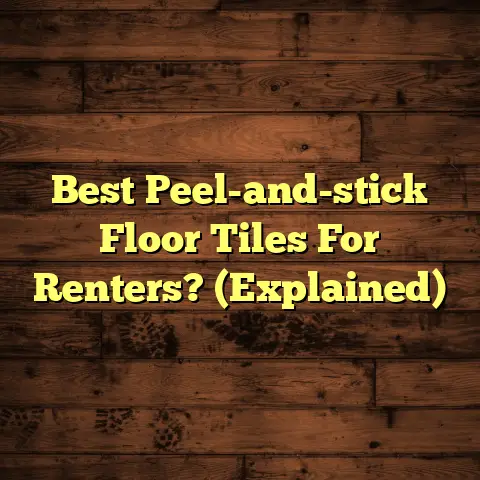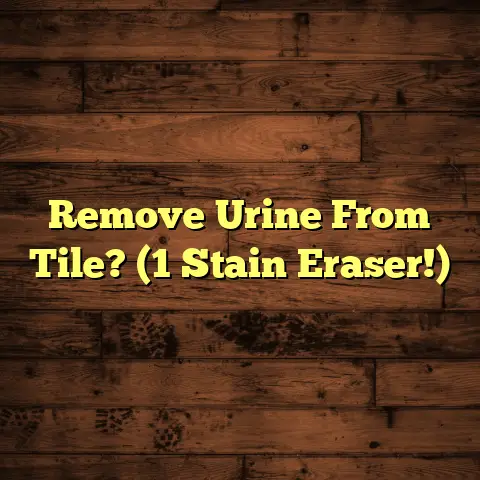How Long Should Floors Last? (3 Red Flags!)
But beyond just aesthetics and function, did you know that your floors can actually impact your health, especially if you’re prone to allergies?
Let’s dive into how long your floors should last, the red flags to watch out for, and what you can do to keep your home healthy and looking its best!
Introduction: Your Floors and Your Health – A Sneaky Connection
Think about it: your floors are a massive surface area in your home, constantly exposed to dust, pet dander, mold spores, and other allergens.
According to the EPA, indoor air can be 2 to 5 times, or even more, polluted than outdoor air. And guess where a lot of that pollution ends up? You guessed it, your floors!
Certain flooring types, like carpets, can be havens for dust mites. Hard surfaces, if not properly maintained, can accumulate mold and mildew, especially in humid environments.
I’ve seen firsthand how replacing old, worn-out flooring can dramatically improve indoor air quality and reduce allergy symptoms.
A study published in the Journal of Allergy and Clinical Immunology found that removing carpets from homes significantly reduced dust mite allergen levels.
So, how long should your floors last? And what are the warning signs that it’s time for a change? Let’s find out!
Section 1: Understanding Flooring Lifespan
Introduction to Flooring Materials
Alright, let’s talk flooring types. Each material has a different lifespan, depending on quality, installation, and how well you take care of it. Here’s a quick rundown:
-
Hardwood: This is the king of longevity! With proper care, hardwood floors can last 100 years or more. I’ve personally worked on homes with original hardwood that still looks stunning after a century.
-
Laminate: A more budget-friendly option, laminate typically lasts 15-25 years. Its lifespan depends heavily on the quality of the wear layer.
-
Tile: Tile is super durable and can last 50-75 years, or even longer. The key here is proper installation to prevent cracks and grout issues.
-
Carpet: Carpet has the shortest lifespan, usually 5-15 years. This varies based on foot traffic, fiber type, and cleaning frequency.
-
Vinyl: Vinyl flooring, including luxury vinyl plank (LVP), can last 10-20 years. LVP is a great option for its water resistance and durability.
Factors Affecting Durability:
- Quality: It’s a no-brainer, but higher-quality materials simply last longer.
- Installation: Poor installation can drastically shorten a floor’s lifespan.
- Environmental Conditions: Humidity, sunlight, and temperature fluctuations can all take a toll.
- Traffic: High-traffic areas wear down faster, obviously.
Importance of Regular Maintenance
Think of your floors like your car – regular maintenance is essential to keeping them in top shape. Here are some tips:
-
Hardwood: Regular sweeping or vacuuming, occasional damp mopping with a wood-specific cleaner, and refinishing every 7-10 years can extend its life dramatically.
-
Laminate: Similar to hardwood, but avoid excessive moisture. Use a laminate-specific cleaner.
-
Tile: Regular grout cleaning is crucial to prevent staining and mold growth. Seal your grout annually.
-
Carpet: Vacuum regularly (at least twice a week!), and get it professionally cleaned every 12-18 months.
-
Vinyl: Sweep and mop regularly with a mild detergent. Avoid harsh chemicals that can damage the finish.
Common Myths About Flooring Lifespan
Let’s bust some myths!
- Myth #1: All hardwood lasts forever. Nope! Neglecting maintenance can ruin even the best hardwood.
- Myth #2: Laminate is waterproof. While water-resistant, laminate isn’t waterproof. Spills need to be cleaned up quickly.
- Myth #3: Tile is indestructible. Tile can crack under pressure or due to improper installation.
- Myth #4: Carpet just needs vacuuming. Vacuuming is important, but professional cleaning is a must to remove embedded dirt and allergens.
Section 2: The Three Red Flags
Okay, let’s get to the meat of the matter. Here are the three major red flags that indicate your floors might be nearing the end of their lifespan:
Red Flag #1: Visible Damage
This one seems obvious, but it’s often ignored until it’s too late. Visible damage can take many forms:
- Cracks in Tiles: Cracks can indicate structural issues underneath or simply wear and tear. Once a tile cracks, moisture can seep in, leading to mold and further damage.
- Warping in Hardwood: Warping is usually caused by moisture. If you see cupping (edges higher than the center) or crowning (center higher than the edges), it’s a sign of moisture problems.
- Stains in Carpet: Persistent stains, especially from pets or spills, can be impossible to remove and can harbor bacteria and allergens.
- Peeling or Bubbling Vinyl: This indicates adhesive failure, often due to moisture or improper installation.
- Gaps in Laminate: Gaps can occur due to expansion and contraction with temperature changes, or from poor installation.
Implications of Ignoring Visible Damage:
- Health Risks: Cracks and gaps provide breeding grounds for mold, mildew, and bacteria.
- Decreased Property Value: Damaged floors are a major turn-off for potential buyers.
- Safety Hazards: Warped floors or cracked tiles can be tripping hazards.
- Further Damage: Ignoring small problems can lead to bigger, more expensive problems down the road.
Red Flag #2: Persistent Allergies and Health Issues
This is where things get personal. I’ve had clients who suffered from allergies for years, only to find that their old flooring was the culprit.
Deteriorating flooring can significantly impact indoor air quality and contribute to allergies in several ways:
- Dust Mite Havens: Carpets, especially older ones, are notorious for harboring dust mites. These microscopic creatures are a major allergy trigger for many people.
- Mold and Mildew Growth: Moisture trapped under flooring can lead to mold and mildew growth, releasing spores into the air.
- VOC Emissions: Some older flooring materials, especially vinyl and laminate, can release volatile organic compounds (VOCs), which can irritate the eyes, nose, and throat.
- Pet Dander Accumulation: Even with regular cleaning, pet dander can accumulate in flooring, especially carpets.
Symptoms to Watch For:
- Increased Sneezing and Coughing: Especially when you’re at home.
- Runny or Stuffy Nose: A common sign of allergic rhinitis.
- Itchy Eyes: Another classic allergy symptom.
- Skin Rashes or Hives: Can be triggered by allergens in the air.
- Asthma Flare-Ups: If you have asthma, poor indoor air quality can worsen your symptoms.
If you’re experiencing these symptoms and can’t pinpoint the cause, consider your flooring. It might be time for an upgrade!
Red Flag #3: Noisy or Unstable Floors
Creaking, popping, or unstable floors are not just annoying; they’re indicators of underlying problems.
- Creaking Hardwood: Can be caused by loose nails, shifting subfloor, or changes in humidity.
- Popping Laminate or Vinyl: Often due to improper installation or uneven subfloor.
- Bouncy or Sagging Floors: This is a serious issue that could indicate structural damage to the subfloor.
- Loose Tiles: Loose tiles can be a sign of adhesive failure or a shifting subfloor.
Potential Structural Damage:
Ignoring these signs can lead to:
- Subfloor Damage: Moisture can seep in and rot the subfloor, leading to expensive repairs.
- Foundation Problems: In severe cases, unstable floors can indicate foundation issues.
- Safety Hazards: Sagging floors can be a tripping hazard and can even collapse.
Don’t ignore those creaks and pops! They’re telling you something is wrong.
Section 3: What to Consider When Evaluating Flooring
Assessing Your Current Flooring
Okay, time to put on your detective hat and assess your floors. Here’s a checklist to guide you:
- Visual Inspection: Look for cracks, warping, stains, peeling, and gaps.
- Smell Test: Do you notice any musty or moldy odors?
- Touch Test: Do the floors feel uneven or unstable?
- Listen Carefully: Do you hear any creaking, popping, or squeaking when you walk?
- Allergy Check: Have your allergy symptoms worsened recently?
When to Call a Professional
While some minor issues can be addressed with DIY repairs, certain situations warrant a professional assessment:
- Extensive Damage: If you see widespread cracking, warping, or peeling.
- Structural Issues: If you suspect subfloor damage or foundation problems.
- Persistent Allergies: If you suspect your flooring is contributing to your allergies.
- Before Buying a Home: Have a flooring expert inspect the floors to identify potential problems before you buy.
Benefits of Professional Evaluation:
- Accurate Diagnosis: A professional can identify the underlying cause of the problem.
- Expert Advice: They can recommend the best course of action for repair or replacement.
- Proper Installation: Professional installation ensures your new floors will last.
- Peace of Mind: Knowing your floors are safe and healthy is worth the investment.
Conclusion
So, how long should your floors last? It depends on the material, the quality, and how well you maintain them. But more importantly, it depends on whether you’re paying attention to the red flags.
Visible damage, persistent allergies, and noisy floors are all signs that it might be time for a change. Don’t ignore these warnings! Your health, safety, and the value of your home depend on it.
Take proactive steps to maintain your flooring, and don’t hesitate to call a professional if you suspect a problem. Your floors are the foundation of your home, so treat them with the care they deserve.





